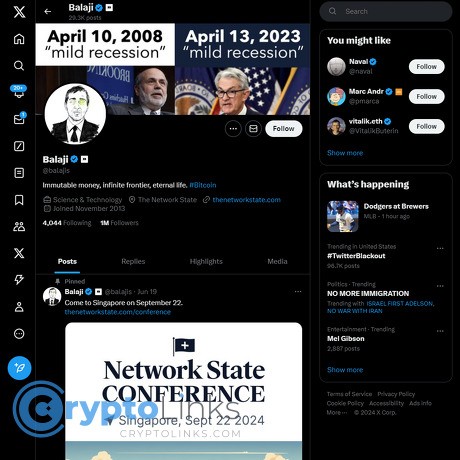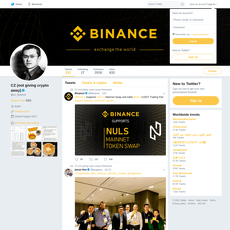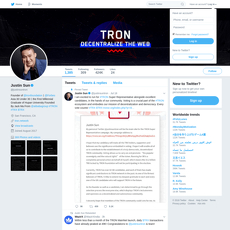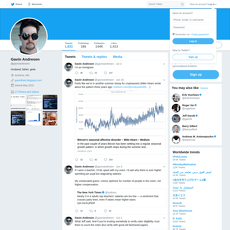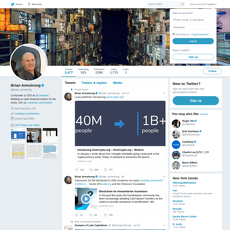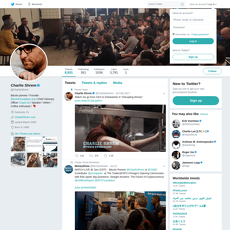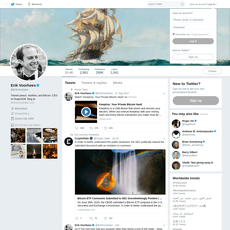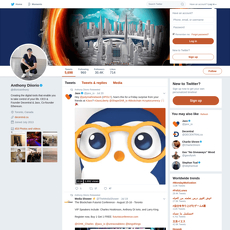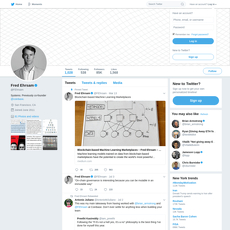Balaji Review
Balaji
x.com
Balaji Review Guide: Everything You Need to Know + FAQ
Thinking about following @balajis on X but not sure if it’s worth your time? If you care about crypto, startups, and the future of digital communities, getting signal from Balaji can save you hours and spark big ideas. I’ll show you what you actually get from his feed, what to watch out for, and how to turn his posts into useful thinking you can apply. I keep a running set of guides like this on Cryptolinks so you don’t have to live on X to stay sharp.
Describe problems or pain
Let’s be real: X can feel like a firehose. With Balaji, it’s amplified—hot takes, long threads, crossovers between crypto, AI, geopolitics, and governance. It’s easy to miss the point or get overwhelmed.
- Too much, too fast: Threads can be 20+ posts and arrive in bursts. You blink and there’s a new framework, chart, or prediction to process.
- Signal vs. noise: Some posts are gold; some are context-setting; some are just quick replies. If your day is packed, you can’t read everything.
- Name confusion: People often mix him up with other Balaji Srinivasans—especially a physician with the same name. Wrong person, wrong take, wasted time.
- Bold claims need a gut check: Big, public bets and macro calls are exciting—but you still need a simple way to sanity-check them before they influence your decisions.
- Attention cost is real: Research shows interruptions can set you back. One well-known study on workplace attention found it can take over 20 minutes to fully refocus after a context switch—exactly what happens when you jump into threads mid-task (Mark, Gonzalez, Harris).
- Speed vs. truth: On social platforms, misinformation can spread faster than facts. An MIT study found false news diffuses significantly farther and faster on Twitter—good reason to add a verification step to any viral claim (MIT / Science 2018).
Promise solution
Here’s what I’m going to do: break down who Balaji is in the crypto world, what his X content actually looks like, and how I separate the signal from the noise. I’ll highlight the big ideas behind his posts so you can understand the context, then give you a simple way to fact-check the bold stuff without getting stuck in analysis paralysis. I’ll also add a quick FAQ to clear up the most common questions.
What you’ll get from this guide
- Clean background: a quick profile so you know why his voice matters in crypto.
- Must-know ideas: the core concepts he returns to (think Network State) so you can read his threads with the right lens.
- Feed tactics: how to follow @balajis without getting overwhelmed—what to read now, what to save, and what to skip.
- Balanced view: strengths and blind spots so you can use his frameworks without copying trades or timelines.
- Useful links: a short list of resources and standout episodes to go deeper fast, all in one place on cryptolinks.com.
Curious why so many builders and investors still make time for his posts—even when they don’t agree with every take? Up next: who he is in crypto, why people listen, and the milestones that shaped his voice. Ready for the 60-second bio that actually matters?
Who is Balaji Srinivasan in crypto?
Quick bio
Balaji Srinivasan blends founder energy with investor reach. He co-founded Counsyl (acquired by Myriad Genetics in 2018), led 21 Inc → Earn.com (acquired by Coinbase), served as Coinbase CTO in 2018–2019, and was an early General Partner at Andreessen Horowitz (a16z). He wrote The Network State—a book that put “cloud-first community building” into one clear framework—and holds a Stanford PhD in engineering.
Key links if you want receipts:
- Coinbase’s acquisition of Earn.com: Coinbase blog
- Coinbase CTO announcement: Coinbase blog
- Counsyl acquisition by Myriad: Myriad press release
- The Network State (book + site): thenetworkstate.com
- Wikipedia overview: Wikipedia
“You have to be a little bit crazy to do great things.”
Why crypto folks listen
He’s unusually good at spotting shifts early and naming them in ways you remember. Years before remote work became default, he was talking about networked communities and cloud-first coordination. That’s not a vibe check—there’s data behind the trend. For example, Stanford’s WFH Research shows around a quarter of paid workdays in the U.S. are still remote as of 2023, versus under 5% before 2020 (WFH Research). He pairs that kind of macro read with crypto-native ideas like on-chain proof, exit over complaint, and founder-style execution.
In short: he connects Bitcoin, startups, and governance into one story—and whether you agree or push back, you end up thinking bigger.
Key milestones you should know
- Counsyl (co-founder): Helped make expanded carrier screening mainstream; later acquired by Myriad. Notably, research from the era (e.g., Lazarin et al., 2013) shows expanded panels materially increased detection across populations (Genetics in Medicine).
- 21 Inc → Earn.com (CEO/chairman): Pushed the idea of paying people in crypto to answer emails and complete tasks—turning attention and expertise into on-chain incentives. Earn.com sold to Coinbase in 2018.
- Coinbase CTO: Brought a builder’s lens to one of crypto’s core companies during a critical scaling phase.
- a16z General Partner: Sat at the crossroads of founders and funding at a firm that bet early on crypto infrastructure and exchanges.
- The Network State (author): Turned years of talks and threads into a book that reframed how online communities can coordinate capital and action, then step into the physical world.
- Public bets and experiments: Willing to make visible, high-stakes calls that force debates (and yes, sometimes controversy) across crypto and macro circles.
Builder first, not just a commentator
Plenty of people post takes. Few have shipped products, raised capital, run teams, and exited companies. That operator history matters because it shapes how he talks about crypto adoption—less about slogans, more about incentives, UX, and distribution.
- Earn.com is a good example: pay-to-respond email sounds simple, but it reframed attention as an asset and used crypto rails to clear microtransactions globally.
- Counsyl shows pattern recognition beyond crypto: use new tech to reduce costs, improve access, and then standardize the category via evidence and partnerships.
What he tends to invest attention in
- Founders > pundits: Incentives and proof over performative debate.
- Sovereignty & regulation: How teams and communities secure rights, capital, and reproducible rules.
- Crypto x AI: Verifiable compute and payments for a machine economy.
- Remote-first coordination: Communities that start online, then touch the real world with receipts.
The reputation (and the tension)
He’s polarizing for the same reason he’s useful: speed. He frames the next 10 years like it’s already loading, and he’s comfortable taking the other side of consensus. That leads to bold calls and timelines that sometimes break early—but it also surfaces edge ideas before they hit your mainstream feed.
So what does this actually look like when you follow him day to day—threads, frameworks, charts, sprints of posting, and the signals worth saving? Let’s look at exactly what you’ll find on @balajis on X and how to filter without getting overwhelmed...
What you’ll find on @balajis on X
If you like feeds that feel like a strategy brief, not a news ticker, this one’s for you. Expect bursts of ideas that can change how you think about crypto, AI, capital flows, and community-building. It’s not small talk—it’s frameworks, receipts, and challenges. And yes, it can be a lot. Here’s how I parse it fast and keep only what’s useful.
Content types and cadence
- Long threads (the “mini-essay” format): 10–40 posts unpacking a thesis—Bitcoin vs. inflation, AI agents paying on-chain, or how founders can “exit” and build alternatives. Threads usually include links, graphs, and a clear “do this” or “watch this” angle.
- Frameworks and checklists: Binary trees, timelines, and “if X, then Y” logic you can plug into your own research. Great for founders and analysts who want mental models.
- Charts with sources: Macro snapshots (CPI, M2, bank failures, remittances, BRICS trade) tied back to crypto adoption or risk. He’ll often cite the original source or a well-known aggregator.
- Book excerpts and visuals: Pieces from The Network State and companion graphics that show how online-first communities can coordinate capital and action.
- Startup playbooks: Notes on recruiting, product loops, and “ship-and-measure” culture aimed at builders.
- Podcast drops and essays: Links to longer talks or write-ups when a thread isn’t enough, often with timestamp highlights.
Cadence: He posts in sprints. During a big news cycle (banking stress, exchange blow-ups, breakthrough AI releases), expect heavy activity. When he’s writing or heads-down, it’s quieter. That rhythm is normal for thinker-builders on X—Pew Research has shown a small share of users produces a big share of content, and it often comes in waves.
“Proof over promises.”
Strengths and blind spots
- What he’s great at:
- Big-picture frameworks that make complex topics click.
- Connecting crypto to governance, AI, and global trends.
- Historical context—reminding you we’ve seen versions of this before.
- What to watch for:
- Speed can outrun nuance; timelines are often aggressive.
- Macro focus means fewer day-trading setups or token-by-token breakdowns.
- Threads assume you’re comfortable cross-checking primary data.
What shows up again and again
- Bitcoin vs. the fiat system: Inflation, bank risk, and why on-chain proof matters.
- AI x Crypto: Machine agents with wallets, paid APIs, and micropayments that actually clear.
- Regulation and sovereignty: Where innovation clusters, how jurisdictions compete, and why founders should understand exit options.
- Community as coordination tech: Online groups raising capital, proving progress, and then acting in the physical world.
Save‑worthy post formats (and how I use them)
- “State of X” threads: I clip the lead thesis, list the linked sources under it, and schedule a 30-day check to see what changed.
- Frameworks: I turn them into a one-page note with my own examples. Learning science is clear: writing your summary boosts recall and judgment.
- Charts with sources: I screenshot the chart and paste the source URL beneath it to avoid link rot. Then I tag it with topics like “BTC-macro,” “AI-agents,” or “policy.”
- Build prompts (“someone should build…”): I forward these to founders or drop them in an idea tracker. They’re often market maps in disguise.
How I set up for signal (not noise)
- Create a “Thinkers” List: Add @balajis and a handful of counterweights (data-first researchers, one macro voice, one policy watcher). Lists cut the chaos dramatically.
- Use a clean search filter: Save this as a bookmark or an X Pro/TweetDeck column:
from:balajis -is:retweet -filter:replies
Add min_faves:300 if you only want the most engaged posts. - Mute what you don’t want: If you’re here for crypto and builders, mute generic political keywords so the feed stays focused.
- Set alerts smartly: Hit the bell for posts, not replies. Then skim via your List, not the main For You timeline.
- 90‑second weekly routine:
- Open your saved filter.
- Save 3 threads that impact your roadmap.
- Write a two-sentence takeaway under each and add one action (read source, test a tool, check on-chain metric).
Pro search filters that actually help
- from:balajis filter:links -is:retweet -filter:replies (only original posts with links)
- from:balajis min_replies:10 -is:retweet (threads that sparked conversation)
- from:balajis since:2024-01-01 -is:retweet -filter:replies (recent originals, no replies)
What not to expect (so you don’t waste time)
- No scalp-trade signals or low-cap token calls.
- No hand-holding walkthroughs—assumes you’ll check sources.
- No constant daily cadence; it’s sprints tied to themes.
Small risks to manage
- Prediction heat: Bold claims can compress timelines in your head. Note the thesis, not the date.
- Echo chamber: Big ideas can feel airtight. Pair the feed with a few skeptics and data dashboards (on-chain analytics, macro calendars).
- Overwhelm: Threads stack up fast. That’s why the “3 threads, 2 sentences, 1 action” routine exists.
Wondering why he keeps returning to online-first communities, on-chain proof, and that famous seven-figure Bitcoin bet? The next section breaks down the big ideas behind the feed—so you can judge the takes with context. Ready for the 60‑second version of the Network State and what that bet was really about?
Big ideas to understand before you judge his takes
The Network State in a nutshell
Before you react to any sweeping thread, it helps to know the operating system behind it. The short version: a Network State starts as an online community with a shared mission, proves its traction with on-chain data, pools capital, and then coordinates in the physical world with measurable milestones. It’s “cloud-first, land-second.”
What that looks like in practice:
- Proof you exist: on-chain treasuries, public metrics (members, contributors, funds raised), and a shared ledger of activity. Think The Network State playbook meets “Don’t trust, verify.”
- Small wins first: pop-up communities and zones that test governance and culture before big commitments. Examples worth studying: Zuzalu (a two‑month pop-up city), CityDAO (land on-chain in Wyoming), Cabin (a networked coliving “city”). These aren’t his projects, but they’re real experiments in the same direction.
- Clear mission, tight feedback loops: communities ship quickly, measure progress publicly, and upgrade governance as they scale. Charter-city research backs the “start small, iterate” approach to policy innovation (see Charter Cities Institute).
“Don’t trust, verify.” — Satoshi Nakamoto
That line is the emotional core here. If a community can show receipts—funding, participation, outcomes—it earns the right to be taken seriously, online or off.
The $1M Bitcoin bet and what it was really about
Yes, the headline was wild. No, Bitcoin didn’t hit $1M in 90 days. But the bet wasn’t just a number; it was a high-voltage stress test on money, banks, and narrative speed during the 2023 regional banking scare.
- Context: SVB and Signature failed in March 2023. The Fed launched the Bank Term Funding Program to stem panic (official BTFP page). Weekly Fed H.8 data showed unusual deposit shifts across banks (H.8 release).
- The wager: He publicly bet that hyper-accelerated monetary expansion and bank risk could catapult BTC to $1M fast (CoinDesk recap). He later settled and paid $1.5M to causes rather than running the full clock (settlement coverage).
- The real takeaway: it forced an open conversation about timelines vs tail risks, self‑custody, and proof. The push for exchange proof‑of‑reserves got louder after FTX and stayed in focus through the banking scare (see Kraken’s PoR explainer).
Agree or not, that bet reframed risk for a lot of busy people who usually ignore balance-sheet plumbing. It wasn’t trading advice; it was a siren.
Exit vs. voice
Balaji often channels Albert Hirschman’s idea: when institutions stagnate, you can use voice (try to fix them) or exit (build alternatives). Crypto’s bias is exit-by-building.
- Voice: petitions, lobbying, standards bodies, policy comment letters.
- Exit: spin up parallel systems—DeFi instead of legacy rails, Farcaster or Lens instead of centralized social, remote‑first communities instead of waiting for local reform.
The emotional hook is agency. You don’t have to wait for permission to start. You can choose the arena where your effort compounds.
Proof over promises
This theme shows up everywhere in his feed: put receipts on-chain and make claims falsifiable.
- Exchanges and treasuries: Merkle‑tree proofs of reserves and liabilities, auditor attestations, and public addresses.
- Public goods and aid: transparent wallets let anyone verify flows—for example, third‑party tracking of crypto donations to Ukraine (Elliptic analysis), or the UN World Food Programme’s blockchain rails for relief (WFP Building Blocks).
- Community health: on-chain governance participation, contributor graphs, and milestone bounties say more than any pitch deck.
In short: fewer press releases, more block explorers.
Regulation and sovereignty
Another recurring thread: jurisdictions are competing. Some move fast, some stall, and teams route around friction.
- Examples of direction: EU’s MiCA clarity, Dubai’s VARA regime, El Salvador’s Bitcoin law explainer (primer).
- Founder reality: capital and talent chase predictable rules. Communities that can move—digitally and physically—gain leverage.
That’s not anti-regulation; it’s about choice and aligned governance. People will go where they’re treated like partners, not suspects.
AI × crypto synergy
He’s bullish on the handshake between AI and crypto. Not hype—there are concrete reasons:
- Agent economies: AI agents need wallets, permissions, and rate limits to interact safely and pay for services.
- Provenance: cryptographic signing can mark content with source, helping fight deepfakes (see the C2PA standard).
- Marketplaces for compute/data: tokenized coordination for GPUs and storage already exists in early forms—Render for rendering, Filecoin for storage, research networks like Bittensor for models. Not endorsements—just proof that builders are testing these ideas.
The shared thesis: AI makes everything faster; crypto makes machine-to-machine interactions accountable.
“Founder energy” applied to society
Startups ship. Communities can, too. That’s the vibe: less complaining, more shipping. From pop-up cities to transparent treasuries to new identity and voting experiments, the call is to act like a founder even when the “company” is your community.
When you read a hot take in his feed, ask: is this a nudge to build or a nudge to argue? The best threads point you toward action you can measure in weeks, not years.
Here’s the real question: how do you separate a bold, useful forecast from a viral overreach—fast enough to protect your time and your stack? In the next section, I’ll share the simple sanity‑check I use (and a few wins/misses that taught me to trust direction over precision). Want the checklist?
How I evaluate and fact-check Balaji’s calls
Balaji’s feed is part strategy memo, part early-warning system. When he’s right, you feel like you got the map a week before everyone else. When he’s off, it’s usually the clock, not the compass. Here’s how I sort the signal from the sizzle in real time.
Wins, misses, and lessons
- Win: early COVID/remote-work reality check. He was beating the drum on early pandemic risk and the downstream shift to remote-first work before it was consensus. The shift is measurable: Gallup shows hybrid/remote stabilized as a new normal post-2020. Lesson: when he flags structural change, it often sticks.
- Win: crypto + AI convergence. Years before it became a mainstream take, he pushed the idea that crypto primitives (identity, provenance, micropayments) would complement AI. You’re now seeing it in projects like Worldcoin, Farcaster frames for agent payments, and provenance standards for generated media. Lesson: frameworks age well, even if examples evolve.
- Mixed: banking stress call was early, timing was hot. The 2023 $1M in 90 days Bitcoin bet didn’t land on the timeline, but the banking stress he cited was very real (see Fed H.8 data on deposit flows after SVB). Lesson: separate directional thesis (fragile banks, rising sovereign risk) from a dated prophecy.
- Miss: aggressive timelines on hyperbitcoinization. Price action didn’t follow the forecasted speed. Lesson: use timelines as scenario prompts, not trading triggers.
“Proof over promises.” — a Balaji mantra worth taping to your screen when a hot take hits your feed.
Bottom line: He’s often right on where the puck is heading, not always on when. I treat his posts like early indicators to investigate, not orders to execute.
My simple playbook to sanity-check a bold claim
- Start with base rates. What’s the historical frequency of the event? For macro claims, I pull FRED series (CPI, M2, yields) and simple trendlines. Superforecasting (Tetlock & Gardner, 2015) shows base-rate thinking beats gut reactions; boldness without base rates is theater.
- Hunt primary data. Crypto is great because the receipts are public. I’ll check:
- Glassnode or Coin Metrics for on-chain supply, realized caps
- DeFiLlama for TVL and stablecoin flows
- Dune dashboards for custom checks
- Kaiko for liquidity and spreads
- Regulatory source docs (SEC/FinCEN PDFs) rather than headlines
- Triangulate with independent voices. I cross-check with:
- Data-heavy analysts: Messari research, Glassnode’s weekly reports, Nic Carter on mining/energy
- Macro: Lyn Alden for fiscal/energy linkages, Jeff Snider for dollar plumbing
- Reg: Coin Center, @jchervinsky, @cburniske for policy/market structure context
- Write your thesis before you act. One paragraph, timestamped. What would change your mind? Keeping a decision journal improves calibration over time (see the Farnam Street guide on decision journals).
- Install a 24-hour pause for portfolio-changing moves. Cooling-off periods reduce impulsive mistakes; Kahneman’s work on the planning fallacy is a reminder that our timelines are often wrong, especially under excitement or fear.
- Score it later. Add a calendar reminder to review outcomes and assign a simple Brier score (0–1). If you do this quarterly, your BS filter levels up fast.
Emotional check I use in practice: If a post makes me feel urgent, I slow down. If it makes me curious, I dig in. Curiosity compounds; urgency taxes.
How I balance the feed so hot takes become useful action
- Pair @balajis with hard data. Follow feeds that publish weekly charts and models:
- Messari intel threads
- Glassnode Insights
- Coin Metrics SOTN
- The Block Data (if you have access)
- Add a macro lens. Yields and dollar liquidity can make or break a great crypto thesis. I keep a small watchlist: DXY, 10Y/2Y spread, oil, and high-yield spreads.
- Keep a regulatory watcher. One legal source can save you from rumor-traps: Coin Center, lawyers like @collins_belton, and updates from @HesterPeirce.
- Use a “proof or park” rule. If there’s no on-chain, primary, or legal-document evidence, I park the idea on my “speculative” list and revisit later.
Real-world example: stress-testing a viral claim
Claim: “Stablecoin supply is signaling the next Bitcoin leg up.”
- Base rate: Historically, rising stablecoin supply has often preceded liquidity waves but not always price uptrends.
- Primary data: Pull stablecoin net issuance on DeFiLlama and exchange balances on Glassnode.
- Cross-check: Compare with funding rates, spot vs. perp premiums (Kaiko), and ETF flows if relevant.
- Action: Note it in the journal, size exposure based on your framework, not the tweet’s confidence.
This is how I turn a big take into a checklist. It keeps the upside of early insights without paying the “got caught in the hype” tax.
Want quick answers to the most common Balaji questions and a short list of starter links so you can go deeper fast? That’s up next—ready for a rapid-fire FAQ and handy resources that cut the scrolling in half?
FAQ and handy resources
Is Balaji Srinivasan a doctor?
Not a medical doctor. He holds a Stanford PhD in engineering. There’s also a different Dr. Balaji Srinivasan who’s a nephrologist (MD). Easy to mix them up—two separate people. If you’re searching on X, the crypto/tech account is @balajis.
What are Balaji’s most famous quotes?
A few lines you’ll see referenced a lot:
“The bottleneck isn’t talent; it’s getting the right people to work on the right problems.”
“You have to be a little bit crazy to do great things.”
“In the innovation economy, you don’t just make things happen once. You make things happen over and over again.”
If you want a quick hit list for context or sales decks, the quote roundups on sites like EarlyNode are handy.
Who is “Balaji Network State”?
Same person. He wrote The Network State and often talks about crypto-powered communities, funding, and governance. Best starting points:
- Book site: thenetworkstate.com (free to read online)
- Podcast deep dive: The Knowledge Project, Ep. #134
- Live feed: @balajis on X
More quick answers
- How often does he post? In sprints. For example, during the March 2023 banking scare (SVB and regional banks), his posting spiked with long threads and rapid updates, then tapered off when he went heads-down on longer work.
- Is he usually right? Often directionally insightful; timelines can be aggressive. A clear case is the $1M Bitcoin bet (2023): it didn’t hit the 90-day timeline, but it put banking risk, fiat fragility, and narrative speed front and center—topics mainstream outlets covered heavily for weeks after.
- Does he share trading calls? He shares frameworks and macro theses more than short-term trades. Treat it like a strategy briefing, not a signals channel.
- What’s the fastest way to “get” him? Skim the Network State site, queue the Knowledge Project interview on a commute, and scroll his pinned or recent long threads on X. You’ll pick up his mental models quickly.
Starter links I recommend
- The Network State (book site) — the core ideas, free online
- @balajis on X — live threads, charts, and frameworks
- The Knowledge Project, Ep. #134 — a structured overview of his thinking
- EarlyNode: Balaji quotes — quick reference for popular lines
How to avoid mix-ups with other Balajis
- Handle check: crypto/tech account is @balajis.
- Context check: If the post is about medicine or hospital practice, it’s likely the nephrologist (a different Balaji Srinivasan).
- Link trail: His official links usually point to the book site, longform interviews, and crypto/startup content.
Examples of when his feed is most useful
- New frameworks: Threads that tie crypto to governance or AI (e.g., proofs, on-chain coordination, “exit vs. voice”). These spark research or product ideas.
- Crisis context: During bank runs or regulatory moves, his threads can surface primary sources and historical parallels you can fact-check fast.
- Founder playbooks: Posts about coordination, community metrics, and “proof over promises” help operators translate big ideas into action items.
Want a simple, battle-tested way to track threads without getting overwhelmed? Next up, I’m sharing the exact setup I use to follow smart, save time, and turn big ideas into action. Ready for the checklist?
How to follow smart and get real value
Here’s how I turn a noisy feed into an actual edge: I set up filters to catch only the high-signal posts, save a handful of must-reads each week with my own notes, and pair the big ideas with primary data before I change anything I do.
Don’t copy trades — steal frameworks.
On X, I keep alerts for original posts and threads, not replies. The easiest way: create a saved search like from:balajis exclude:replies (min_retweets:200 OR min_faves:800) and pin it as a column in X Pro (TweetDeck). That surfaces the “anchor” tweets that kick off threads and the posts that actually move conversation, not the one-liners in replies.
When a post triggers action, I sanity-check with on-chain dashboards (Dune, Token Terminal), public datasets (FDIC, FRED), and a couple of independent analysts I trust. If the thesis still holds 24 hours later, I move.
Quick checklist to stay sane
- Add @balajis to a “Thinkers” list and put that list on your home screen. Keep it separate from price chatter.
- Save 3 threads per week with your own 3–5 line summary. Retrieval practice improves recall and judgment over time (see Karpicke & Blunt, Science 2011).
- Cross-check sweeping claims with primary sources:
- On-chain: Dune, Token Terminal, Coin Metrics
- Macro/finance: FRED, FDIC Quarterly Banking Profile
- Balance your feed with counterweights:
- Data-first: Kaiko Research, Glassnode
- Macro: Lyn Alden
- Policy: Coin Center
Multiple independent sources reduce echo-chamber risk (PNAS 2016). - Use a 24-hour rule before acting on any post that would change your portfolio or roadmap. Checklists and cooling-off steps cut costly errors (NEJM 2009 checklist study).
A weekly routine that actually works
- Monday (10 min): Open your saved search from:balajis exclude:replies (min_retweets:200 OR min_faves:800). Bookmark 1–2 posts you want to track.
- Wed/Thu (15 min): Add quick notes under each saved thread: “thesis,” “evidence posted,” “my counter.” If it’s about stablecoins, pull a fresh chart on supply or velocity from Coin Metrics or Dune.
- Friday (30 min focus block): Pick one thread, unroll it, and pair it with data:
- If it’s about banking risk, scan FDIC’s latest unrealized losses note in the Quarterly Banking Profile.
- If it’s about AI x crypto, check adoption stats (e.g., account abstraction activity via AA reports from Alchemy), plus protocol revenues on Token Terminal.
Write a 5-sentence takeaway for future you. That’s how you turn ideas into playbooks. - Sunday (5 min): Trim your alerts or add a new filter if the noise creeps in.
Real sample: from post to action
Scenario: He argues “stablecoins will keep eating remittances.”
- What I pull: World Bank’s remittance fee tracker (global average still ~6% in many corridors: link), stablecoin transfer volumes and supply growth (Coin Metrics SoTN), and a Dune dashboard for USDT/USDC usage by region.
- My check: Are costs actually lower in the corridor I care about? Is on/off-ramp availability improving? Any new policy shifts?
- My output: A simple note: “If fees >5% and on/off-ramps exist, pilot a stablecoin payout with $X cap next month.” No trade, just an experiment with clear success metrics.
This is the pattern I repeat: bold claim → primary data → small, reversible test.
Make alerts work for threads (not replies)
- Saved search method:from:balajis exclude:replies (min_retweets:200 OR min_faves:800). Pin as a column in X Pro. That catches thread starters and high-signal posts.
- Automation option: With Zapier/IFTTT, trigger on new posts by @balajis, then filter “Text contains ‘1/’ OR ‘Thread’ OR length > 200 characters” and push to a Telegram/Slack channel labeled “Threads.”
- Keep it tight: If alerts feel noisy, raise thresholds (min_retweets:400). You want fewer, better pings.
What I’m watching next
- Network-state style experiments: community-first governance and financing models that “ship society.” Examples to track: Cabin (networked neighborhoods), pop-up city experiments like Zuzalu-style gatherings, and charter city updates from places like Próspera.
- Crypto x AI tooling: decentralized compute and agent economies (e.g., Akash, Render, Bittensor, Ritual). I’m looking for real usage curves, not press releases.
- Proof-of-reserves that actually proves something: zk-verified PoR with assets and liabilities, plus auditor attestations. Benchmarks: OKX PoR, Kraken PoR. I favor exchanges that publish methods and let users verify inclusion.
- Founders applying “exit” locally: transparent community treasuries on Open Collective, Gitcoin-funded public goods, and energy/infra co-ops using on-chain rails (see Energy Web).
Wrap-up
Use the feed like a strategy briefing, not a trading signal. Set clean filters, save a few threads with your own notes, and test ideas against hard data. If this helped, bookmark it and check back on cryptolinks.com — I keep guides like this updated so you can stay sharp without living on X.
CryptoLinks.com does not endorse, promote, or associate with Twitter accounts that offer or imply unrealistic returns through potentially unethical practices. Our mission remains to guide the community toward safe, informed, and ethical participation in the cryptocurrency space. We urge our readers and the wider crypto community to remain vigilant, to conduct thorough research, and to always consider the broader implications of their investment choices.

